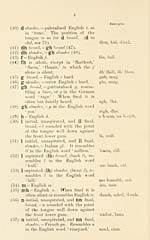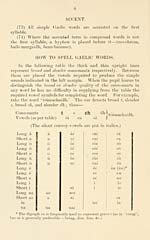Download files
Complete book:
Individual page:
Thumbnail gallery: Grid view | List view

(58) n aspirated (nh) hroad, (back n), = n
m the English word ' nun.'
(59) n aspirated (nh) slender, (front n), =
n in the English word ' ninny.'
(60) p = English /;>. (Final p, see 70).
(61) ph = English f.
(62) r hmnd, (back /•), = in the English
word ' run.' It is always trilled.
(6:5) F dmdcr, (front ?•), = front English r.
It is always trilled.
(6-i) S orodd, =.s in the English word ' so.'
It is silent after t-. In the Gaelic
words 'so' ('here') and ' sud'
('yonder'), it has the sound of s in
' sugar.'
(65) S ■■iletider,=s in the English word
' sugar.' It is silent after t-.
(66) sh = English A.
(67) t ljro(i.d, = t sounded with the point
of the tongue well down against
the front lower gum. Final t,
see 70)
(68) t ■s/e;H/rr, = palatalised ^. Resembles
English tch, or (/, voiceless, or t in
the English word ' tune.' The
position of the tongue is as with t
hroad. (Final t, see 70).
(69) th = English h. It is silent in the
word ' thù' (' thou').
(70) C, p, t, are explodent. C final, and
p and t after short vowels, take
the explosion, oi breathing before
them, in most dialects.
chd = chc.
Examples
mo nàire, dan.
mo nighean, mi
pòg, pìos.
phòs, phinn.
run, mor.
rithist, cir.
caise, sni, cis.
sheas, shàr.
tonn, tàl, tog.
thà, sath, thoo-.
(72)
n after initial c,
gnùis, mnaoi).
mac = mahc ; ap =
ahp ; cat = caht.
luchd = luchc ; ochd
= ochc.
md ?», is commonlv sounded /•— (cnoc,
m the English word ' nun.'
(59) n aspirated (nh) slender, (front n), =
n in the English word ' ninny.'
(60) p = English /;>. (Final p, see 70).
(61) ph = English f.
(62) r hmnd, (back /•), = in the English
word ' run.' It is always trilled.
(6:5) F dmdcr, (front ?•), = front English r.
It is always trilled.
(6-i) S orodd, =.s in the English word ' so.'
It is silent after t-. In the Gaelic
words 'so' ('here') and ' sud'
('yonder'), it has the sound of s in
' sugar.'
(65) S ■■iletider,=s in the English word
' sugar.' It is silent after t-.
(66) sh = English A.
(67) t ljro(i.d, = t sounded with the point
of the tongue well down against
the front lower gum. Final t,
see 70)
(68) t ■s/e;H/rr, = palatalised ^. Resembles
English tch, or (/, voiceless, or t in
the English word ' tune.' The
position of the tongue is as with t
hroad. (Final t, see 70).
(69) th = English h. It is silent in the
word ' thù' (' thou').
(70) C, p, t, are explodent. C final, and
p and t after short vowels, take
the explosion, oi breathing before
them, in most dialects.
chd = chc.
Examples
mo nàire, dan.
mo nighean, mi
pòg, pìos.
phòs, phinn.
run, mor.
rithist, cir.
caise, sni, cis.
sheas, shàr.
tonn, tàl, tog.
thà, sath, thoo-.
(72)
n after initial c,
gnùis, mnaoi).
mac = mahc ; ap =
ahp ; cat = caht.
luchd = luchc ; ochd
= ochc.
md ?», is commonlv sounded /•— (cnoc,
Set display mode to: Large image | Transcription
Images and transcriptions on this page, including medium image downloads, may be used under the Creative Commons Attribution 4.0 International Licence unless otherwise stated. ![]()
| Early Gaelic Book Collections > Blair Collection > How to learn Gaelic > (15) |
|---|
| Permanent URL | https://digital.nls.uk/79789234 |
|---|
| Description | A selection of books from a collection of more than 500 titles, mostly on religious and literary topics. Also includes some material dealing with other Celtic languages and societies. Collection created towards the end of the 19th century by Lady Evelyn Stewart Murray. |
|---|
| Description | Selected items from five 'Special and Named Printed Collections'. Includes books in Gaelic and other Celtic languages, works about the Gaels, their languages, literature, culture and history. |
|---|

